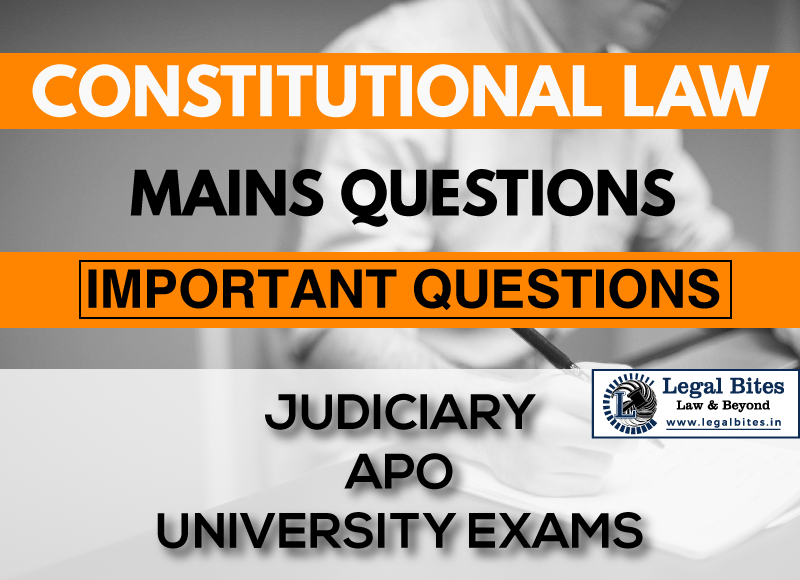If there is clash between two Fundamental Rights, what course should be taken by the courts? Discuss in light of decided cases.
Find the answer to the mains question of Constitutional Law only on Legal Bites.

Question: If there is clash between two Fundamental Rights, what course should be taken by the courts? Discuss in light of decided cases.Find the answer to the mains question of Constitutional Law only on Legal Bites. [If there is clash between two Fundamental Rights, what course should be taken by the courts? Discuss in light of decided cases.]AnswerWhen a clash or conflict arises between two Fundamental Rights in a constitutional democracy like India, the courts play a crucial role...
Question: If there is clash between two Fundamental Rights, what course should be taken by the courts? Discuss in light of decided cases.
Find the answer to the mains question of Constitutional Law only on Legal Bites. [If there is clash between two Fundamental Rights, what course should be taken by the courts? Discuss in light of decided cases.]
Answer
When a clash or conflict arises between two Fundamental Rights in a constitutional democracy like India, the courts play a crucial role in resolving such conflicts. Indian Constitution under Article 32 and Article 226 empowers the Supreme Court and High Courts, respectively, to enforce Fundamental Rights. To adjudicate on cases involving a clash between two Fundamental Rights, courts typically follow a set of principles and tests, which have evolved through various decided cases. Here is a discussion of how courts approach such conflicts, with reference to some notable cases:
Harmonious Construction: The courts generally strive for a harmonious construction of Fundamental Rights. This means that they attempt to interpret and apply the rights in a way that minimizes conflicts and allows both rights to coexist. In the case of Bijoe Emmanuel v. State of Kerala, (1987) AIR 748, the Supreme Court held that the right to freedom of religion (Article 25) and the right to education (Article 21A) could coexist. The Court ruled that three children from the Jehovah's Witness community who refused to sing the national anthem on religious grounds could not be expelled from school.
Balancing Test: In situations where harmonious construction is not possible, courts employ a balancing test to weigh the competing rights and determine which right should prevail in a given context. The test involves assessing the importance and necessity of each right in particular circumstances. In Maneka Gandhi v. Union of India, (1978) AIR 597, the Supreme Court introduced the principle of reasonableness to the right to travel abroad (Article 21). This case established that a law infringing on a Fundamental Right must be reasonable, and the courts have the power of judicial review to determine its reasonableness.
Doctrine of Proportionality: The doctrine of proportionality is often used by courts to adjudicate on conflicts between Fundamental Rights. It requires that any restriction on a Fundamental Right should be proportionate to the goal it seeks to achieve. In Modern Dental College and Research Centre v. State of Madhya Pradesh, Civil Appeal No. 4060 of 2009, the Supreme Court emphasized that the Doctrine of Proportionality must be applied to assess the reasonableness of any restriction on Fundamental Rights.
Test of Imminent Danger: In cases involving a conflict between the right to freedom of speech and expression (Article 19(1)(a)) and other rights or interests, courts have often applied the "imminent danger" test. This test assesses whether the exercise of free speech poses an imminent danger to another Fundamental Right. In the Ramlila Maidan Incident (2012), the Supreme Court held that the right to peaceful assembly (Article 19(1)(b)) could be restricted to prevent an imminent danger to public order.
Proper Forum: In some cases, the courts may refer a matter to the appropriate forum to resolve the conflict. For example, if a conflict arises between the right to privacy and national security concerns, the court may refer the matter to a specialized tribunal or commission with expertise in handling national security issues, as seen in the case of Aadhaar (2020).
In conclusion, when faced with a clash between two Fundamental Rights, the courts in India adopt a nuanced approach that includes harmonious construction, balancing tests, proportionality, and consideration of the imminent danger posed by the exercise of a right. The specific approach depends on the facts and circumstances of each case, and the courts strive to ensure that the essence of both rights is protected while resolving the conflict. The goal is to strike a delicate balance between the rights of individuals and the interests of the state or society.
Important Mains Questions Series for Judiciary, APO & University Exams
- Constitutional Law Mains Questions Series Part-I
- Constitutional Law Mains Questions Series Part-II
- Constitutional Law Mains Questions Series Part-III
- Constitutional Law Mains Questions Series Part-IV
- Constitutional Law Mains Questions Series Part-V
- Constitutional Law Mains Questions Series Part-VI
- Constitutional Law Mains Questions Series Part-VII
- Constitutional Law Mains Questions Series Part-VIII
- Constitutional Law Mains Questions Series Part-IX
- Constitutional Law Mains Questions Series Part-X

Mayank Shekhar
Mayank is an alumnus of the prestigious Faculty of Law, Delhi University. Under his leadership, Legal Bites has been researching and developing resources through blogging, educational resources, competitions, and seminars.

